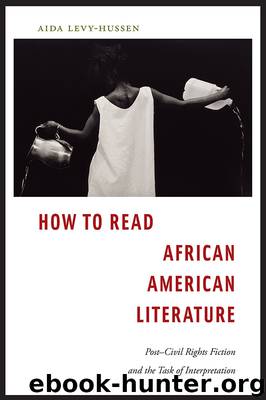How to Read African American Literature by Aida Levy-Hussen

Author:Aida Levy-Hussen [Levy-Hussen, Aida]
Language: eng
Format: epub
Tags: LIT004040 Literary Criticism / American / African American
Publisher: NYU Press
Racial Depression
But perhaps we should push back against the psychoanalytic desire to confine identification to a consolidated, knowable structure—particularly, one that calcifies loss and injury in the psychic form of the racialized person. How else might we imagine the purview of racial grief’s effects? Dilating on a keyword that at once evokes and turns away from the theoretical genealogy of melancholia, Ann Cvetkovich’s recent monograph, Depression, draws on affect theory to reorient the discourse on racism and psychic life. Wary of psychoanalysis’s capacity to distract us from direct and transparent ways in which political injustice produces psychic malaise, she encourages a retreat from the logic of internalization and the development of alternative, anti-pathologizing conceptualizations of psychic distress. Through a vocabulary that foregrounds neither symptoms nor identity types but feelings, she aims to tie systemic socio-political analyses directly to “everyday . . . feelings of despair and anxiety, sometimes extreme, sometimes throbbing along at a low level . . . feelings that get internalized and named, for better or for worse, as depression.”35
Cvetkovich is one of several contemporary theorists who turn to affect theory to expand upon psychoanalytic understandings of depression by attending to feelings as important indices of social and psychic truth. The point is, not a disproof of psychoanalysis, but an inquiry into how feelings may amplify and texture a psychoanalytic portraiture of the self. As Eve Sedgwick asserts, where psychoanalysis meditates primarily on structures of desire and identification, affect theory gives us interpretive access to “an array of perceptual data . . . whose degree of organization hovers just below the level of shape or structure.”36 If this is so—if affect theory can illuminate our understanding of black psychic life by making the intensities of feeling that color loss available to discourse—then what does such a theoretical tool mean for our reading of post–Civil Rights racial melancholia?37
Let us return, briefly, to the scene with which I opened this chapter, a scene in which Sarah Phillips—a privileged constituent of the post–Civil Rights black bourgeoisie—appears to recognize herself in her boyfriend’s wildly inaccurate, racist caricature of the American South. The versions of racial melancholia I have sketched in the preceding pages lend themselves to various logics for understanding this scene. We might, for example, claim that Sarah sees herself in this story because she has ambivalently internalized a racist gaze or because melancholia works by redirecting social rage into self-beratement. From this perspective, the narrative “event” is a scene of mis-recognition that brings into view a mappable, melancholic psychic structure. But just as surely, this is a scene that is about something other than event and structure. It is a scene that is at pains to describe an effusion of inconstant feeling that never matriculates to a psychoanalytically legible form: fury, shame, isolation, confusion, betrayal, resignation, and an intense and “nameless emotion” (12).
What if we imagined form as something short of the final word on meaning, heeding Sedgwick’s warning that “to describe [affect] primarily in terms of structure is always
Download
This site does not store any files on its server. We only index and link to content provided by other sites. Please contact the content providers to delete copyright contents if any and email us, we'll remove relevant links or contents immediately.
| African | Asian |
| Australian & Oceanian | Canadian |
| Caribbean & Latin American | European |
| Jewish | Middle Eastern |
| Russian | United States |
4 3 2 1: A Novel by Paul Auster(11788)
The handmaid's tale by Margaret Atwood(7447)
Giovanni's Room by James Baldwin(6808)
Asking the Right Questions: A Guide to Critical Thinking by M. Neil Browne & Stuart M. Keeley(5355)
Big Magic: Creative Living Beyond Fear by Elizabeth Gilbert(5351)
Ego Is the Enemy by Ryan Holiday(4956)
On Writing A Memoir of the Craft by Stephen King(4662)
The Body: A Guide for Occupants by Bill Bryson(4582)
Ken Follett - World without end by Ken Follett(4443)
Bluets by Maggie Nelson(4261)
Adulting by Kelly Williams Brown(4232)
Eat That Frog! by Brian Tracy(4149)
Guilty Pleasures by Laurell K Hamilton(4116)
White Noise - A Novel by Don DeLillo(3829)
The Poetry of Pablo Neruda by Pablo Neruda(3814)
Fingerprints of the Gods by Graham Hancock(3738)
Alive: The Story of the Andes Survivors by Piers Paul Read(3730)
The Book of Joy by Dalai Lama(3697)
The Bookshop by Penelope Fitzgerald(3619)
